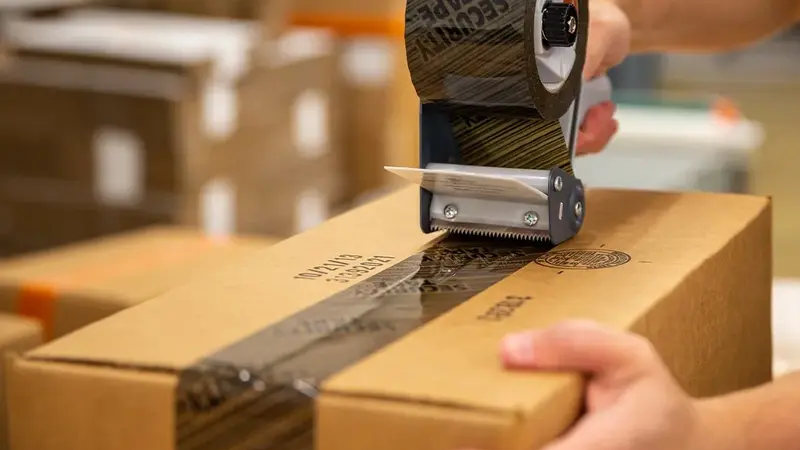Maintaining a secure supply chain is necessary for businesses of all sizes because it can impact profitability, reputation, and customer satisfaction. However, with the increasing complexity of global supply chains, securing assets has become a significant challenge. So, how can we enhance supply chain security?
Well, one of the most effective ways to secure the supply chain is by using tamper-evident solutions. These solutions, including labels, seals, and tapes, provide a visible layer of protection, ensuring that unauthorized access is immediately detected. Here’s everything you need to know about supply chain security and tamper-evident solutions.
What is Supply Chain Security?
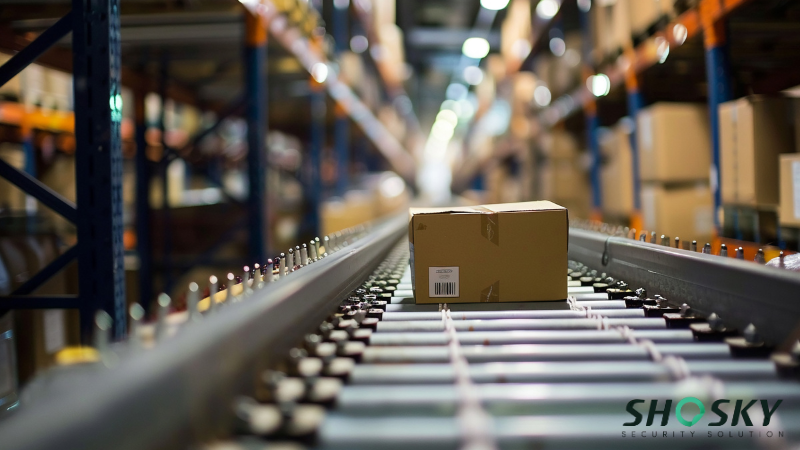
Supply chain security is a comprehensive framework of measures and strategies put in place to protect every stage of a product’s journey.
The ultimate goal of robust supply chain security is to ensure a seamless and safe flow of goods, maintaining not only product integrity but also fostering unwavering consumer trust. When security measures are effective, businesses can operate with confidence, and customers can rely on receiving authentic, untampered products.
This overarching concept extends to both the tangible and intangible aspects of commerce: physical security (protecting actual goods and infrastructure) and digital security (shielding the information and systems that govern these movements).
However, achieving this seamless flow is challenging due to the various threats that can disrupt supply chain operations, impacting both businesses and consumers significantly. For instance, Gartner predicts that by 2025, 45% of organizations worldwide will have experienced attacks on their software supply chains, a threefold increase from 2021.
Here’s a deeper look at some of the most pervasive risks:

- Theft: Stealing goods during transportation or storage, leading to financial and inventory losses.
- Counterfeit Goods: Fake products are infiltrating the supply chain, harming brand reputation and customer trust.
- Tampering: Unauthorized access to packages or shipments, which can damage goods or compromise safety.
- Fraud: Manipulating records, labels, or shipment details for illicit gain.
- Cybersecurity Threats: Breaches of logistics systems, exposing sensitive data, and disrupting operations.
For businesses, these risks mean higher costs, delayed deliveries, and potential penalties. For customers, they can lead to safety concerns and a loss of confidence in a brand. Therefore, prioritizing supply chain security is crucial for protecting assets and ensuring a positive experience for everyone involved.
How to Enhance Supply Chain Security?
Enhancing supply chain security requires a comprehensive approach that tackles both digital and physical risks. Protecting your goods from origin to destination means securing them in the digital realm as well as in the physical world.
Digital Security Measures

In today’s interconnected world, a robust digital security management system is absolutely essential. These systems act as your first line of defense against a wide array of cyber threats, from sophisticated cyberattacks and data breaches to unauthorized access and system manipulation.
Think of it as setting up a digital fortress around your supply chain’s information. This involves:
- Advanced Monitoring: Continuously watching for unusual activities or potential vulnerabilities within your digital networks.
- Access Controls: Ensuring that only authorized personnel can access sensitive supply chain data and systems.
- Data Encryption: Protecting information as it moves between different points in your supply chain, making it unreadable to anyone without the proper key.
- Cybersecurity Protocols: Implementing strong firewalls, antivirus software, and regular security updates to prevent malicious intrusions.
By diligently managing digital security, you ensure the integrity of your data, the accuracy of your logistics, and the smooth operation of your entire supply chain, protecting it from unseen threats that can cause massive disruption and financial loss.
Physical Security Measures
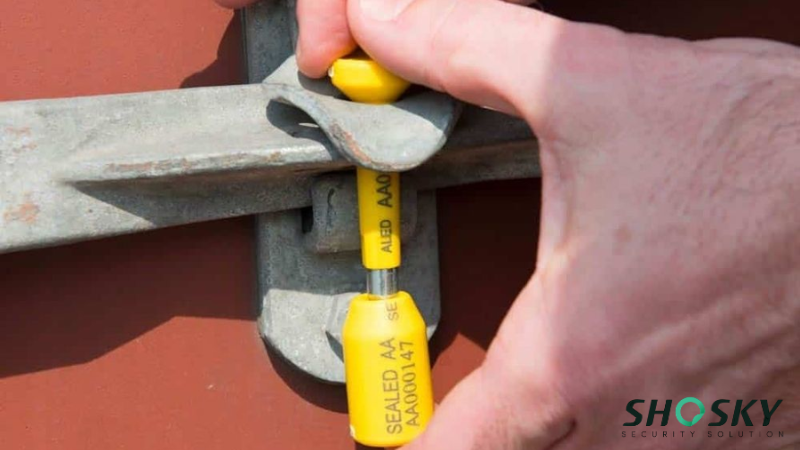
While digital threats are growing, the physical security of goods in transit remains paramount. To deter and detect physical interference, tamper-evident products are incredibly valuable tools.
These aren’t just ordinary seals; they are designed to provide visible proof of tampering. If someone tries to open, alter, or compromise a package or container, the tamper-evident seal will show clear, irreversible signs, such as:
- A “VOID” message appears.
- A torn or shredded surface.
- A change in color or texture.
This immediate visual evidence ensures product integrity from the moment an item is packaged until it reaches its final destination. It’s a powerful deterrent and a critical aid in investigations if a breach occurs.
By combining stringent digital defenses with robust physical safeguards, businesses can significantly strengthen their supply chain, protect valuable assets, and build greater trust with their customers.
Types of Tamper-Evident Solutions for Supply Chain Security
Securing the supply chain relies on various tamper-evident solutions, each designed to prevent and detect unauthorized access or tampering. Below are the main types of tamper-evident tools and their specific applications in supply chain operations.
Tamper-Evident Labels

Tamper-evident labels are specially designed labels to show clear signs of interference when an attempt is made to remove or alter them. Unlike regular labels, these labels are embedded with advanced security features such as adhesives that leave behind visible residue, patterns, or messages when peeled off. They work as a reliable method to deter tampering and ensure the authenticity of products.
Here are the common types of tamper-evident labels:
- Void Labels: Void labels leave a clear “VOID” message upon removal, instantly indicating tampering. This is a simple yet effective method, often used, for example, in pharmaceutical packaging.
- Destructible Labels: Ultra-destructible labels are designed to break into pieces when tampered with, making any attempt to remove them easily detectable. The resulting damage provides irrefutable proof of interference. The material’s inherent fragility adds a layer of security.
- Holographic Labels: Incorporating complex, reflective holograms, these labels offer enhanced security against counterfeiting. The intricate design makes replication extremely difficult, adding a visual layer of protection. Different colors and patterns can be used to further enhance security.
These labels are especially useful for securing pharmaceuticals, where product integrity is critical, and for high-value electronics and luxury goods, where authenticity needs verification. They also serve to protect important documents and packaging, providing a reliable method of identifying tampering or unauthorized access.
Tamper-Evident Seals
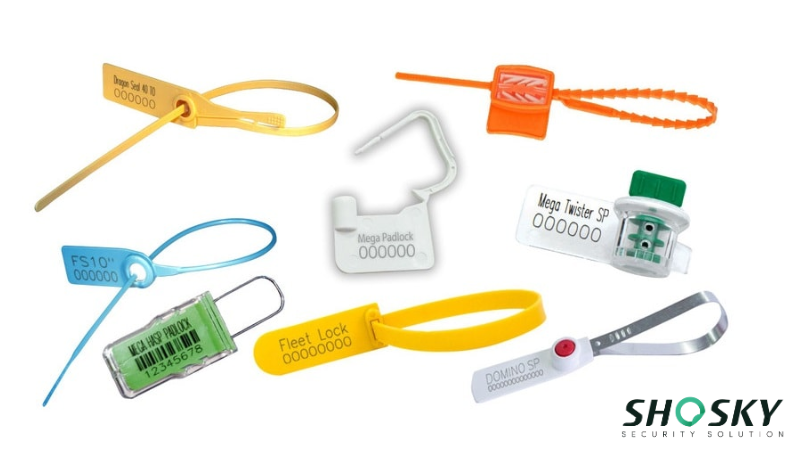
Tamper-evident or security seals are physical devices designed to secure shipments and packaging while providing clear evidence if they have been opened. Unlike regular seals, these seals include features like serial numbers, barcodes, or unique designs that make replication or tampering more difficult.
Here are the common types of tamper-evident seals:
- Plastic Security Seals: These are versatile seals suitable for securing general shipments and packages. They are often used with a unique code or barcode for tracking.
- Cable Seals: Ideal for securing high-value or sensitive items, cable seals offer enhanced security due to their robust construction and difficulty in removal without causing visible damage.
- Padlock Seals: Providing high security for larger doors or containers, these seals require a specific key or combination for removal, making them suitable for high-security applications.
- Container Seals: Specifically designed for shipping containers, these seals prevent unauthorized access and provide clear evidence of tampering. They often incorporate a unique identification code.
- Metal Strap Seals: These are used to secure high-security equipment and machinery, offering exceptional resistance to tampering. Their robust construction and difficulty in removal without leaving visible signs of damage make them a top choice for high-value assets.
These seals are ideal for protecting shipping containers during transport in the supply chain, ensuring that no unauthorized person can access the goods without detection. They are also effective for securing equipment and sensitive shipments in high-security areas, providing peace of mind during transit.
Tamper-Evident Tape

Tamper-evident tape or security tape is a specialized adhesive tape designed to provide clear evidence of tampering if removed or repositioned. Unlike ordinary tape, it leaves behind visible markings, such as residue or text, or becomes unusable once detached. This simple yet effective solution offers a cost-effective way to enhance security.
Here are the common types of tamper-evident tape:
- Full Transfer Security Tape: This tape leaves a visible message on the surface to which it was applied when removed. The message is often “VOID” or a similar indicator of tampering.
- Non-Transfer Security Tape: This tape displays tamper evidence without leaving residue on the surface. The tape itself shows signs of removal or alteration.
- Partial Transfer Security Tape: This tape leaves some residue while retaining part of the message on the tape itself, providing dual evidence of tampering.
- Serial Number & Perforation Security Tape: This tape incorporates unique serial numbers or perforations for added security and traceability. This allows for improved tracking and verification. A barcode or other code could also be incorporated.
Tamper-evident tapes are highly effective for securing boxes, crates, and pallets during transportation, as they show clear signs of tampering if the package is opened or disturbed. They also ensure the integrity of sensitive documents or packages, particularly in the case of valuable or time-sensitive shipments.
How to Integrate Tamper-Evident Solutions into Your Supply Chain Strategy?

Incorporating tamper-evident solutions into your supply chain strategy is essential for safeguarding products against theft, tampering, and counterfeiting. To do this effectively, businesses must assess their vulnerabilities, select appropriate solutions, and implement best practices for their use.
Step 1: Assess Your Current Supply Chain Security
The first step in strengthening your supply chain security is to evaluate the current security measures in place and identify any weak points where tampering or theft could potentially occur. This process involves a comprehensive review of each stage of the supply chain, starting from the point of manufacturing all the way to the final delivery.
By mapping out the entire journey of your products, you can pinpoint high-risk areas where security breaches are more likely, such as storage facilities, transit routes, or the packaging process.
Besides, it is also crucial to assess existing security protocols, from access control to monitoring systems, to ensure they are robust enough to mitigate risks.
In some cases, new measures such as tamper technologies and tamper-evident solutions could be implemented to strengthen weak points. By addressing these gaps, you can ensure a safer, more secure supply chain
Step 2: Choose the Right Tamper-Evident Solutions
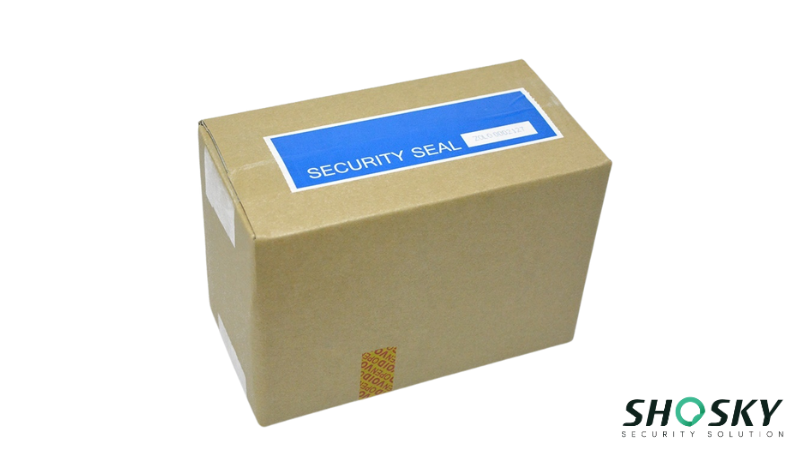
Once you’ve identified the vulnerabilities in your supply chain, the next step is to select tamper-evident solutions tailored to your industry, product type, and security requirements.
For industries dealing with high-value or sensitive products, such as pharmaceuticals or electronics, solutions like holographic or destructible labels are ideal due to their advanced security features and difficulty in replication.
Conversely, businesses shipping larger items or industrial equipment may opt for heavy-duty container security seals, such as metal straps or plastic security seals, which offer greater durability and can withstand harsh transit conditions.
It’s crucial to align the tamper-evident solutions with the specific risks and security needs of the products being transported. To ensure the best fit, it may be helpful to consult with various service providers and experts who can guide you in selecting the right solution for your specific needs.
Step 3: Implement Tamper-Evident Solutions
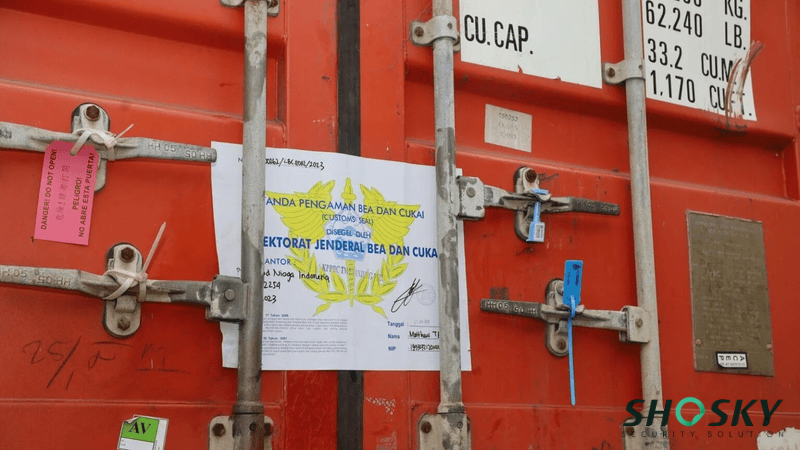
Once you have chosen the taper-evident solution, the next and final step is to implement this solution. Successful integration of tamper-evident solutions requires careful planning and execution. Here are some key practices to follow:
- Staff Training: Employees must be trained on how to apply and inspect tamper-evident labels, seals, and tapes. They should also understand the importance of monitoring these solutions and identifying signs of tampering.
- Response Processes: Develop a clear protocol for responding to tampering incidents. This includes reporting, investigating, and taking corrective action to prevent future occurrences.
- Operational Integration: Tamper-evident technology should be seamlessly incorporated into packaging, logistics, and warehousing operations. For instance, apply tamper-evident seals during packaging, and use tamper-evident tape for securing shipments.
- Testing and Monitoring: Periodically test the effectiveness of the solutions in use and monitor their performance across different stages of the supply chain. Adjustments may be needed to address new vulnerabilities or changes in operational requirements.
Integrating tamper-evident solutions strengthens supply chain security and ensures that products reach customers safely and intact. By taking these steps, businesses can enhance their reputation, reduce losses, and build customer trust in the safety and authenticity of their offerings.
Best Practices to Choose the Right Tamper-Evident Solution
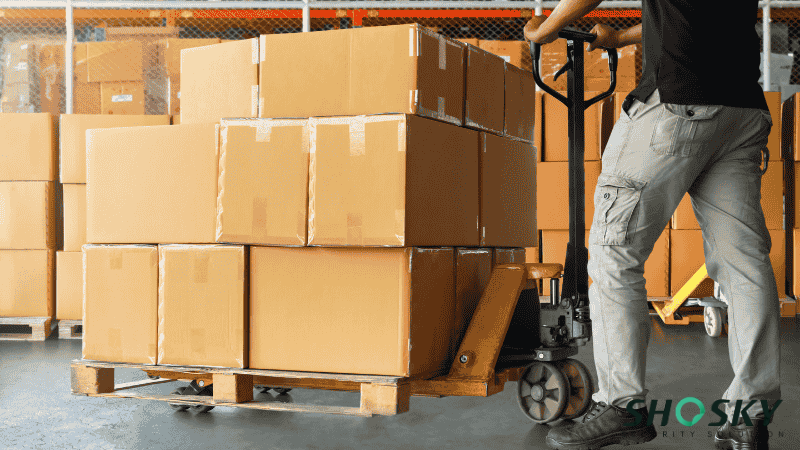
Choosing the right tamper-evident solution requires following the best practices. Best practices include considering key factors, understanding the pros and cons of various options like security labels, seals, and tapes, and aligning them with your specific needs.
Here are the key factors you need to follow to choose the right tamper-evident solutions:
- Product Type: What type of product do you need to secure? Fragile or high-value items, such as electronics or pharmaceuticals, may require highly secure options like void labels or heavy-duty seals.
- Shipping Conditions: What are shipping conditions? Long-distance or harsh transit conditions call for durable solutions like tamper-evident tape or seals that can withstand extreme temperatures, humidity, or rough handling.
- Industry Regulations: Industries like pharmaceuticals and food must adhere to strict compliance standards, requiring FDA-approved or other certified tamper-evident solutions.
Once you have identified your specific needs, it’s crucial to weigh the advantages and disadvantages of the available tamper-evident options to make an informed decision.
Here’s an overview of the key benefits offered by tamper-evident labels, seals, and tapes:
However, like any security measure, these solutions also come with certain limitations that banks should consider before implementation. Understanding these potential drawbacks ensures a more informed decision-making process for comprehensive security.
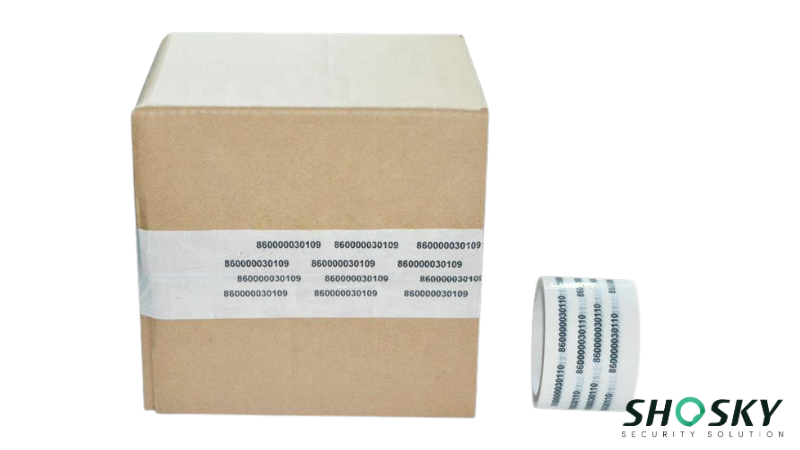
Now, let’s look at the cons associated with each type of tamper-evident product:
| Tamper-Evident Labels | Tamper-Evident Seals | Tamper-Evident Tapes |
|---|---|---|
| Adhesive may fail under extreme conditions | Higher cost compared to labels | Adhesive may weaken in harsh conditions |
| Limited durability for long-term or high-stress | Application may require tools, adding complexity | Less effective for small or high-value items |
| Unsuitable for large or heavy-duty applications | Often single-use, increasing overall costs | Customization options may be limited |
After evaluating the pros and cons of tamper-evident solutions, it’s essential to choose the right option that aligns with your security needs, product type, and operational goals.
Labels are ideal for lightweight or retail items, offering customization and affordability. Seals provide durability for larger shipments, while tamper-evident tape works best for securing boxes and packages during transit. Balancing security level with ease of application ensures smooth integration into your processes.
Note: A well-chosen tamper-evident strategy not only protects your supply chain but also builds trust with customers and partners.
FAQs
What are the objectives of supply chain security?
The main objectives are to protect goods from theft, tampering, and counterfeiting while ensuring smooth operations and shipment integrity.
Are tamper-evident solutions suitable for all types of products?
Yes, tamper-evident solutions are suitable for most products, especially high-value or regulated items like electronics and pharmaceuticals.
Can tamper-evident solutions be reused?
No, tamper-evident solutions are designed for single use. Once tampered with, they leave visible signs of damage, making them ineffective for reuse.
Conclusion
The impact of supply chain vulnerabilities can be devastating to a business. Tamper-evident packaging solutions, however, act as a visible safeguard. So, by carefully selecting and integrating these solutions into your supply chain strategy, you can reduce vulnerabilities, enhance security, and safeguard your reputation.
Choose Shosky Security!
Shosky Security specializes in tamper-evident products designed for various industries, providing robust solutions to protect your shipments. Explore our products today and contact us to take the first step toward enhancing your supply chain security!
